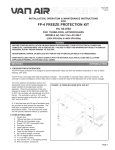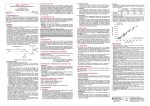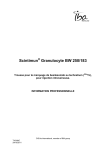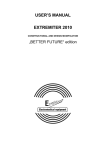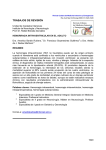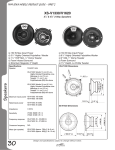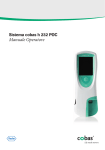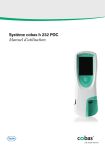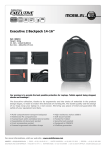Download Test Rapido D-Dimero a dischetto per Sangue Intero
Transcript
Gima S.p.A. - Via Marconi, 1 - 20060 Gessate (MI) Italy Italia: tel. 199 400 401 - fax 199 400 403 Export: tel. +39 02 953854209/221/225 fax +39 02 95380056 [email protected] - [email protected] www.gimaitaly.com Test Rapido D-Dimero a dischetto per Sangue Intero e Plasma Rapid D-Dimer Test Disk for Whole Blood and Plasma Test Rapide D-Dimères sur carte pour sang total et plasma Test Rápido Dímero-D en disquete para Sangre Entera y Plasma M24526-M-Rev.0-09.09 MANUALE D’USO OPERATOR’S MANUAL MANUEL D’UTILIZATION MANUAL DE USO ATTENZIONE: Gli operatori devono leggere e capire completamente questo manuale prima di utilizzare il prodotto. ATTENTION: The operators must carefully read and completely understand the present manual before using the product. AVIS: Les opérateurs doivent lire et bien comprendre ce manuel avant d’utiliser le produit. ATENCIÓN: Los operadores tienen que leer y entender completamente este manual antes de utilizar el producto. ITALIANO 2 Il D-Dimero è un prodotto della degradazione della fibrina (FDPs), che avviene quando la fibrina viene demolita per l’azione degli enzimi. I D-Dimeri sono unici per la loro capacità di rompere grazie alla Plasmina di una rete di Fibrina precedentemente stabilizzata dal Fattore XIII. Questo fattore lega un elemento-E a due elementi-D. Questa è la fase finale nella generazione di un trombo. Livelli elevati di D-Dimero sono un’indicazione di fibrinolosi attiva questo è stato dimostrato nei pazienti con coagulazione intravasale diffusa (DIC), trombosi venosa profonda (TVP) e embolia polmonare. Il test rapido cromatografico immunoassay D-Dimero per la rilevazione qualitativa del DimeroD nel sangue intero e nel plasma. La sensibilità del test è approsimativamente di 80ng/ml (DIMERTEST Gold EIA) o di 300ng/ml (Dade Behring Stratus Cs – DDMR). Concentrazioni elevate di D-Dimero indicano un aumento dell’attività coagulatoria e fibrinolitica. MATERIALI INCLUSI Il kit test D-Dimero contiene i seguenti oggetti per eseguire l’analisi; 1. Test D-Dimero. 2. Istruzioni. 3. Contagocce monouso. 4. Tampone sviluppatore. PRECAUZIONI I Dispositivi Test rapido D-Dimero dovrebbero essere conservati a una temperatura compresa tra i 4 e i 30C° (40-86°F). Il dispositivo test è sensibile all’umidità, come anche al calore. Esegui il test immediatamente dopo aver rimosso il dispositivo test dalla confezione. Non utilizzare dopo la data di scadenza. RACCOLTA E CONSERVAZIONE DEI CAMPIONI 1. Il test dovrebbe essere effettuato utilizzando solo sangue intero e plasma umano. 2. Sangue anti coagulato con l’eparina, EDTA o citrato di sodio sono necessari per la raccolta del sangue intero. 3. Il sangue campione deve essere utilizzato immediatamente dopo la raccolta. 4. I campioni che mostrano segni di coagulazione non sono adatti ad essere testati. 5. Se i campioni non sono testati immediatamente, devono essere raffreddati dai 2-8 gradi C°. I campioni di sangue intero dovrebbero essere testati entro 24 ore, mentre il plasma dovrebbe essere usato entro 4 giorni. Per periodi di conservazione superiori a 2 mesi, è consigliato il congelamento a -2°C. 6. I campioni contenenti precipitate potrebbero produrre esiti incoerenti. Tali campioni devono essere raffinati prima di procedere con il test. AVVERTENZE 1. Solo per uso diagnostico in vitro. 2. Non maneggiare i campioni mentre si mangia o si fuma. 3. Indossare guanti protettivi mentre si maneggiano i campioni. Lavare le mani accuratamente dopo l’uso. 4. Evitare spruzzi e formazioni di aerosol. 5. Pulire le fuoriuscite accuratamente usando un disinfettante appropriato. 6. Decontaminare e disporre tutti i campioni in un contenitore a rischio biologico, kit di reazione e materiali potenzialmente contaminati, come se si trattasse di rifiuti infettivi. 7. Non utilizzare il kit se la confezione è danneggiata o il sigillo è rotto. 3 ITALIANO MODALITÀ D’USO 1. Rimuovere il test a dischetto dalla confezione e posizionarlo su una superficie piana e asciutta. 2. Utilizzare il contagocce per prelevare il campione di sangue, spremere accuratamente il contagocce prima di prelevare il campione (che produce un campione di sangue intero di volume 20 μl) come mostrato in Figura 1, o se si utilizza il plasma, usare una pipetta (Non inclusa) per prelevare 10 μl di plasma come campione. 3. Versare lentamente il campione alla finestra campione (Figura 2). 4. Aggiungere poi 2 gocce del tampone (Figura 3). Non appena il test comincerà a funzionare si vedrà una striscia color porpora muoversi attraverso la finestra dei risultati al centro del test a dischetto. 5. Interpretare i risultati del test tra gli 8 e i 10 minuti. Non interpretarli dopo 10 minuti. ATTENZIONE La fascia di tempo soprastante in cui interpretare il test si basa su una lettura del test a una temperatura ambientale tra i 15 e 30 °C. Se la temperatura della stanza in cui si esegue il test è inferiore a 15 °C, allora la tempistica di interpretazione dovrebbe essere incrementata correttamente. INTERPRETAZIONE DEL TEST 1. Una striscia colorata apparirà nella sezione sinistra della finestra di risultato mostrando che il test funziona correttamente. Questa è la striscia di Controllo. La sezione destra della finestra di risultato indica i risultati del test. Se appare un’altra striscia colorata nella sezione destra della finestra di risultato, questa è la striscia Test. POSITIVO: DUE STRISCE COLORATE La presenza di due striscie all’interno della finestra di risultato, indipendentemente da quale appare prima indica un risultato positivo (Figura 4). NEGATIVO: STRISCIA MONOCOLORE La presenza di una sola striscia all’intero della finestra di risultato indica un risultato negative (Figura 5). NON VALIDO: Se dopo aver eseguito il test non compare nessuna striscia nella finestra di risultato, il test è considerato non valido (Figura 6). L’esecuzione erronea del test o l’uso di un kit deteriorato possono compromettere il risultato. Si consiglia che il campione venga ri-testato. 4 ITALIANO LIMITAZIONI DEL TEST Concentrazioni alte di D-Dimero (maggiori di 60μg/ml) possono produrre strisce a bassa intensità (effetto prozona). Gli anticorpi anti-mouse umani possono falsare i risultati.Come in tutti i prodotti diagnostici, una bassa incidenza di risultati falsati potrebbe presenentarsi. Come per tutti i test diagnostici, una diagnosi clinica definitiva non dovrebbe essere basata sui risultati di un singolo test, ma dovrebbe essere fatta esclusivamente da un dottore dopo che tutti i risultati clinici e di laboratorio siano stati valutati correttamente. CONFRONTO DELLE PRESTAZIONI E STUDI DI SENSIBILITÀ La sensibilità del test è di circa 80ng/ml (DIMERTEST Gold EIA) o 300ng/ml (Dade Behring Stratus CS – DDMR). La sensibilità relativa del Test D-Dimero di GIMA è del 97% (174/178) e la specificità è del 92% (114/122) in confront al sistema immunoassay di Dade Behring Stratus CS – DDMR. STUDI SULLA SPECIFICITÀ E LE INTERFERENZE Si sta conducendo uno studio interno sul plasma e sul sangue intero per determinate la Specificità e l’Interferenza del test D-Dimero. I composti testati comprendono : le concentrazioni plasmatiche di Trigliceridi fino a 500 mg/ml, concetrazioni di Bilirubina fino a 10mg/100ml, i campioni Emolizzati con concentrazioni di emoglobina fino a 10mg/ml, Fosfatasi acida prostatica con concentrazioni fino a 1000 mIU/ml e con concentrazioni di albumina fino a 20 mg/ml. Tutti i suddetti sono stati analizzati e non hanno mostrato interferenze o reattività incrociate con il test. BIBLIOGRAFIA 1. Gaffney PJ, Brasher M. Subunit structure of the plasmin-induced degradation products of cross-linked fibrin. Biochem Biophys Acta. 1973;295: 308–313. 2. Lowe GDO, Rumley A. Use of fibrinogen and fibrin D-dimer in prediction of arterial thrombotic events. Thromb Haemost. 1999;82: 667–672. 3. Lip GYH, Lowe GDO. Fibrin D-dimer: a useful clinical marker of thrombogenesis? Clin Sci Mol Med. 1995;89:205–214. 4. Shaper AG, Pocock SJ, Walker M, et al. British Regional Heart Study: cardiovascular risk factors in middle-aged men in 24 towns. BMJ. 1981; 283:179 –186. ICONOGRAFIA Attenzione, consultare le istruzioni per l’uso Contenuto Fabbricante Solo per uso diagnostico in vitro Usare entro Non riutilizzare Temp. di conservazione Numero del lotto Codice 24526 GIMA Spa Via Marconi, 1 Fabbricante 20060 Gessate (MI) - Italia 5 ENGLISH D-Dimer is a Fibrin Degradation Products (FDPs), which are formed whenever fibrin is broken down by enzymes. D-dimers are unique in that they are the breakdown products by plasmin of a fibrin mesh that has been stabilised by Factor XIII. This factor crosslinks the E-element to two D-elements. This is the final step in the generation of a thrombus. Elevated levels of D-Dimer are an indication of active fibrinolysis and have been shown in patients with disseminated intravascular coagulation (DIC), deep vein thrombosis (DVT), pulmonary emblolism. The Rapid D-Dimer Test is a chromatographic immunoassay for the qualitative detection of DDimer in human whole blood and plasma. The sensitivity of the test is approximately 80ng/ml (DIMERTEST Gold EIA) or 300ng/ml (Dade Behring Stratus CS – DDMR) Elevated concentrations of D-dimer indicated increased coagulatory and fibrinolytic activity. MATERIALS PROVIDED The D-Dimer test kit contains the following items to perform the assay; 1. D-Dimer test. 2. Instructions. 3. Disposable sample dropper. 4. Developing buffer. PRECAUTIONS The Rapid D-Dimer Test devices should be stored at room temperature 4-30oC (40-86oF). The test device is sensitive to humidity as well as to heat. Perform the test immediately after removing the test device from the foil pouch. Do not use it beyond the expiration. SPECIMEN COLLECTION AND STORAGE 1.The test may be performed using human whole blood and plasma only. 2.Blood anticoagulated with heparin, EDTA or sodium citrate are required for whole blood collection. 3.Figure tip blood must be used immediately after collection. 4.Specimen showing evidence of clotting are not suitable for testing. 5.If specimens are not immediately tested they should be refrigerated at 2-8oC. Whole blood specimen should be tested within 24 hours, and plasma should used in 4 days. For storage periods greater up to 2 month, freezing at -2oC is recommended. 6.Specimens containing precipitate may yield inconsistent test results. Such specimens must be clarified prior to assaying. WARNINGS 1.For in vitro diagnostic use only. 2.Do not eat or smoke while handling specimens. 3.Wear protective gloves while handling specimens. Wash hands thoroughly afterwards. 4.Avoid splashing or aerosol formation. 5.Clean up spills thoroughly using an appropriate disinfectant. 6.Decontaminate and dispose of all specimens, reaction kits and potentially contaminated materials, as if they were infectious waste, in a biohazard container. 7.Do not use the test kit if the pouch is damaged or the seal is broken. PROCEDURE 1.Remove the test disk from the foil pouch, and place it on a flat, dry surface. 2. Use the sample dropper to draw blood sample, fully squeeze the dropper prior drawing the sample blood (which produces a sample volume of about 20 μl of whole blood) as shown in ENGLISH 6 Figure 1, or if plasma is used, use a pipette (not provided) to draw 10μl of plasma as sample. 3. Slowly add sample to the sample well (Figure 2). 4. Then add 2 drops of the buffer (Figure 3). As the test begins to work, you will see purple color move across the Result Window in the center of the Test Disk. 5. Interpret test results at 8 to 10 minutes. Do not interpret test result after 10 minutes. CAUTION The above interpretation time is based on reading the test results at room temperature of 15 to 30 degrees C. If your room temperature is significantly lower than 15 degrees C, then the interpretation time should be properly increased. INTERPRETATION OF THE TEST 1. A color band will appear in the left section of the Result Window to show that the test is working properly. This band is the Control Band. The right section of the Result Window indicates the test results. If another color band appears in the right section of the Result Window, this band is the Test Band. POSITIVE RESULT: TWO COLOR BANDS The presence of two bands within the Result Window, regardless of which band appears first indicates a positive result (Figure 4). NEGATIVE RESULT: ONE COLOR BAND The presence of only one band within the Result Window indicates a negative result (Figure 5). INVALID RESULT: If after performing the test no band is visible within the Result Window, the result is considered invalid (Figure 6). The directions may not have been followed correctly or the test may have deteriorated. It is recommended that the specimen be re-tested. LIMITATIONS OF THE TEST Very high concentration of D-Dimer (greater than 60μg/ml) can lead to reduced test line intensity (prozone effect). Human anti-mouse antibodies can lead to falsely elevated results. As with all other diagnostic products, a low incidence of false results can occur. Other clinically available tests are required if questionable results are obtained. As with all diagnostic tests, a definitive clinical diagnosis should not be based on the results of a single test, but should only be made by the physician after all clinical and laboratory findings have been evaluated. 7 ENGLISH PERFORMANCE CHARACTERISTICS - COMPARISON AND SENSITIVITY STUDIES The sensitivity of the test is approximately 80ng/ml (DIMERTEST Gold EIA) or 300ng/ml (Dade Behring Stratus CS – DDMR) The relative sensitivity of the GIMA D-Dimer test is 97% (174/178) and the specificity is 92% (114/122) when compared to Dade Behring Stratus CS – DDMR Immunoassay System. SPECIFICITY AND INTERFERENCE STUDY An in-house study is conducted on spiked plasma or whole blood Test to determine the Specificity and Interference of D-Dimer test. Compounds tested include: Plasma with triglyceride concentrations up to 500 mg/ml, Bilirubin concentrations up to 10 mg/100ml, Hemolyzed specimens with hemoglobin concentrations up to 10mg/ml, Prostatic acid phosphatase with concentrations up to 1000 mIU/ml and Albumin with concentrations up to 20 mg/ml. All of the above were analyzed and did not show interference or cross reactivity with the test. REFERENCES 1. Gaffney PJ, Brasher M. Subunit structure of the plasmin-induced degradation products of cross-linked fibrin. Biochem Biophys Acta. 1973;295: 308–313. 2. Lowe GDO, Rumley A. Use of fibrinogen and fibrin D-dimer in prediction of arterial thrombotic events. Thromb Haemost. 1999;82: 667–672. 3. Lip GYH, Lowe GDO. Fibrin D-dimer: a useful clinical marker of thrombogenesis? Clin Sci Mol Med. 1995;89:205–214. 4. Shaper AG, Pocock SJ, Walker M, et al. British Regional Heart Study: cardiovascular risk factors in middle-aged men in 24 towns. BMJ. 1981; 283:179 –186. GRAPHICAL SYMBOLS USED Attention, see instructions for use Contents Manufacturer For in vitro diagnostic use only Use by Do not reuse Storage temperature Lot Number Catalog 24526 GIMA Spa Via Marconi, 1 Manufacturer 20060 Gessate (MI) - Italia FRANÇAIS 8 Les D-Dimères sont les produits de dégradation de la fibrine (PDF), qui a lieu quand la fibrine est démolie sous l’action des enzymes. Les D-Dimères sont uniques de par leur capacité de rompre, grâce à la plasmine, un réseau de fibrine précédemment stabilisé par le Facteur XIII. Ce facteur lie un élément-E à deux éléments-D. C’est la phase finale de la formation d’un thrombus. Des taux élevés de D-Dimères indiquent l’existence d’une fibrinolyse active. Cela a été prouvé chez les patients présentant des pathologies, telles que la coagulation intravasculaire disséminée (CIVD), la thrombose veineuse profonde (TVP) et l’embolie pulmonaire (EP). Le test de détection rapide immuno-chromatographique D-Dimères est un test qualitatif pour l’évaluation du taux des D-Dimères dans le sang total et dans le plasma. La sensibilité du test est approximativement de 80ng/ml (DIMERTEST Gold EIA) ou de 300ng/ml (Dade Behring Stratus Cs – DDMR). Des taux élevés de D-Dimères indiquent une augmentation de l’activité coagulante et fibrinolytique. MATÉRIEL FOURNI Le kit du test D- Dimères contient : 1. Test D-Dimères. 2. Mode d’emploi. 3. Pipette jetable. 4. Solution tampon. PRÉCAUTIONS Les composants du Test rapide D-Dimères doivent être conservés à une température comprise entre 4 et 30 °C (40-°F). Le test est sensible à l’humidité et à la chaleur. Exécuter le test aussitôt après avoir retiré le dispositif de l’emballage. Ne pas utiliser après la date de péremption. RECUEIL ET CONSERVATION DES ÉCHANTILLONS 1. N’utiliser que du sang total et du plasma humains pour ce test. 2. Utiliser le sang coagulé avec de l’héparine, de l’EDTA ou du citrate de sodium. 3. L’échantillon de sang doit être utilisé aussitôt après le prélèvement. 4. Ne pas utiliser les échantillons présentant des caillots. 5. Si les échantillons ne sont pas testés immédiatement, ils doivent être refroidis à une température comprise entre 2 et 8 °C. Les échantillons de sang total doivent être testés dans un délai de 24 heures, alors que le plasma doit être utilisé dans un délai de 4 jours. Pour des périodes de conservation de plus de 2 mois, nous conseillons de les congeler à une température de -2 °C. 6. Les échantillons contenant des précipités pourraient fausser les résultats. Ces échantillons doivent être clarifiés avant de procéder au test. AVERTISSEMENT 1. Pour diagnostic in vitro uniquement. 2. Ne pas fumer ou manger pendant la manipulation des échantillons. 3. Porter des gants de protection lors de la manipulation des échantillons. Se laver soigneusement les mains après utilisation. 4. Éviter les projections et la formation d’aérosol. 5. Nettoyer soigneusement les débordements en utilisant un désinfectant approprié. 6. Décontaminer et traiter tous les échantillons, kits réactifs et matériaux potentiellement infectieux comme s’il s’agissait de déchets infectieux. Par conséquent, ceux-ci devront être éliminés dans un conteneur pour matériaux biologiques contaminés. 7. Ne pas utiliser les kits de test si l’emballage est endommagé ou si le sceau est brisé. 9 FRANÇAIS MODE OPÉRATOIRE 1. Retirer le test de l’emballage et le poser sur une surface plate et sèche. 2. Utiliser la pipette pour prélever l’échantillon de sang, presser soigneusement la pipette avant de prélever l’échantillon (à savoir un échantillon de 20 μl de sang total) comme indiqué dans la figure 1, ou si on utilise le plasma, utiliser une pipette (non fournie) pour prélever un échantillon de 10 μl de plasma. 3. Verser lentement l’échantillon dans le puits d’échantillon (Figure 2). 4. Puis ajouter 2 gouttes de la solution tampon (Figure 3). Dès que le test commence à réagir, une ligne de couleur pourpre commence à faire son apparition à travers la fenêtre des résultats au centre du test. 5. Interpréter les résultats du test dans un délai de 8 à 10 minutes. Ne pas les interpréter au-delà de 10 minutes. ATTENTION L’intervalle de temps cité plus haut au cours duquel le test doit être interprété se base sur une lecture du test à une température ambiante comprise entre 15 et 30 °C. Si la température de la pièce dans laquelle on exécute le test est inférieure à 15 °C, augmenter le temps d’interprétation en conséquence. INTERPRÉTATION DES RÉSULTATS 1. Une ligne colorée apparaît dans la section gauche de la fenêtre de résultat, montrant ainsi que le test fonctionne correctement. C’est la ligne de la zone de contrôle. La section droite de la fenêtre de résultat indique les résultats du test. Si une autre ligne colorée apparaît dans la section droite de la fenêtre de résultat, il s’agit de la ligne de test. POSITIF : LIGNES BICOLORES La présence de deux lignes à l’intérieur de la fenêtre de résultat, indépendamment du fait que l’une ou l’autre apparaisse en premier, indique un résultat positif (Figure 4). NÉGATIF : LIGNE D’UNE SEULE COULEUR La présence d’une seule ligne à l’intérieur de la fenêtre de résultat indique un résultat négatif (Figure 5). NON VALIDE : Si après avoir exécuté le test, aucune ligne n’apparaît dans la fenêtre de résultat, le test n’est pas valide (Figure 6). Une mauvaise procédure d’exécution du test ou l’emploi d’un kit détérioré peuvent fausser le résultat. Dans ce cas, l’examen doit être répété. 10 FRANÇAIS LIMITES DU TEST Des taux élevés de D-Dimères (plus de 60μg/ml) peuvent produire des lignes de faible intensité (effet prozone). Les anticorps humains anti-souris peuvent fausser les résultats. Comme c’est le cas pour tous les produits diagnostiques, une basse incidence de résultats faussés pourrait se présenter. Comme pour tous les tests diagnostiques, un diagnostic clinique définitif ne devrait pas être basé sur les résultats d’un seul test, mais devrait être exclusivement réalisé par un médecin une fois que celui-ci a correctement évalué tous les résultats cliniques et de laboratoire. COMPARAISON DES PERFORMANCES ET ÉTUDE DE SENSIBILITÉ La sensibilité du test est approximativement de 80ng/ml (DIMERTEST Gold EIA) ou de 300ng/ ml (Dade Behring Stratus CS – DDMR). La sensibilité relative du Test D-Dimères de GIMA est de 97 % (174/178) et la spécificité est de 92 % (114/122) en comparaison avec le système de Dade Behring Stratus CS – DDMR. ÉTUDES SUR LA SPÉCIFICITÉ ET LES INTERFÉRENCES Une étude interne sur le plasma et sur le sang total visant à déterminer la spécificité et l’interférence du test D-Dimères est en cours. Les composants testés comprennent : les concentrations plasmatiques de triglycérides jusqu’à 500 mg/ml, les concentrations de bilirubine jusqu’à 10mg/100ml, les échantillons hémolysés avec des concentrations d’hémoglobine jusqu’à 10mg/ml, la phosphatase acide prostatique avec des concentrations jusqu’à 1000 mIU/ml et avec des concentrations d’albumine jusqu’à 20 mg/ml. Tous les composants susdits ont été analysés et aucune interférence ou réactivité croisée avec le test n’a été observée. BIBLIOGRAPHIE 1. Gaffney PJ, Brasher M. Subunit structure of the plasmin-induced degradation products of cross-linked fibrin. Biochem Biophys Acta. 1973;295: 308–313. 2. Lowe GDO, Rumley A. Use of fibrinogen and fibrin D-dimer in prediction of arterial thrombotic events. Thromb Haemost. 1999;82: 667–672. 3. Lip GYH, Lowe GDO. Fibrin D-dimer: a useful clinical marker of thrombogenesis? Clin Sci Mol Med. 1995;89:205–214. 4. Shaper AG, Pocock SJ, Walker M, et al. British Regional Heart Study: cardiovascular risk factors in middle-aged men in 24 towns. BMJ. 1981; 283:179 –186. LISTE DES SYMBOLES Attention, consulter la notice d’utilisation Contenu Fabricant Pour diagnostic in vitro uniquement. Date de péremption Usage unique Température de stockage N° de Lot Code 24526 Fabricant GIMA Spa Via Marconi, 1 20060 Gessate (MI) - Italia 11 ESPAÑOL El Dímero-D es un producto de la degradación de la fibrina (FDPs), que ocurre cuando la fibrina es demolida por la acción de los enzimas. Los Dímeros-D son únicos por su capacidad de romper gracias a la Plasmina de una red de Fibrina precedentemente estabilizada por el Factor XIII. Este factor enlaza un elemento-E a dos elementos-D. Esta es la fase final en la generación de un trombo. Niveles elevados de Dímero-D son una indicación de fibrinolisis activa, esto se ha demostrado en los pacientes con coagulación intravasal diseminada (DIC), trombosis venosa profunda (TVP) y embolia pulmonar. El test rápido cromatográfico inmunoensayo Dímero-D para la detección cualitativa del DímeroD en la sangre entera y en el plasma. La sensibilidad del test es aproximadamente de 80ng/ml (DIMERTEST Gold EIA) o de 300ng/ml (Dade Behring Stratus Cs – DDMR). Concentraciones elevadas de Dímero-D indican un aumento de la actividad de coagulación y fibrinolítica. MATERIALES INCLUIDOS El kit test Dímero-D contiene los siguientes objetos para realizar el análisis; 1. Test Dímero-D. 2. Instrucciones. 3. Cuentagotas desechable. 4. Tampón revelador. PRECAUCIONES Los Dispositivos Test rápido Dímero-D han de conservarse a una temperatura incluida entre 4 y 30C° (40-86°F). El dispositivo test es sensible a la humedad y al calor. Efectuar el test inmediatamente después de haber quitado el dispositivo test del estuche. No utilizar después de la fecha de caducidad. RECOLECCIÓN Y CONSERVACIÓN DE LAS MUESTRAS 1. El test se tendría que realizar utilizando solo sangre entera y plasma humano. 2. Sangre coagulada con la heparina, EDTA o citrato sódico son necesarios para la recolección de la sangre entera. 3. La sangre muestra ha de utilizarse inmediatamente después de la recolección. 4. Las muestras que tienen signos de coagulación no son adecuadas para ser testadas. 5. Si las muestras no son testadas inmediatamente, han de ser enfriadas entre 2-8 grados C°. Las muestras de sangre entera tendrían que ser testadas dentro de 24 horas, mientras que el plasma tendría que ser usado dentro de 4 días. Por períodos de conservación superiores a los 2 meses, se aconseja la congelación a -2°C. 6. Las muestras que contienen precipitado podrían producir resultados incoherentes. Dichas muestras han de ser refinadas antes de proceder con el test. ADVERTENCIAS 1. Solo para uso diagnóstico in vitro. 2. No manipular las muestras mientras se come o se fuma. 3. Llevar guantes de protección al manejar las muestras. Lavar las manos esmeradamente después del uso. 4. Evitar salpicaduras y formaciones de aerosol. 5. Limpiar esmeradamente los escapes usando un desinfectante apropiado. 6. Descontaminar y colocar todas las muestras en un contenedor a riesgo biológico, kit de reacción y materiales potencialmente contaminados, como si se tratara de residuos infecciosos. 7. No utilizar los kit test si el estuche está dañado o el sello está roto. ESPAÑOL 12 MODALIDAD DE EMPLEO 1. Quitar el test de disquete del estuche y colocarlo sobre una superficie llana y seca. 2. Utilizar el cuentagotas para coger la muestra de sangre, apretar esmeradamente el cuentagotas antes de coger la muestra (Que produce una muestra de sangre entera de 20 μl de volumen) como mostrado en Figura 1, o si se utiliza el plasma, usar una pipeta (No incluida) para coger 10 μl de plasma como muestra. 3. Verter lentamente la muestra en la ventana muestra (Figura 2). 4. Luego añadir 2 gotas del tampón (Figura 3). En cuanto el test empiece a funcionar se verá una tira color púrpura moverse a través de la ventana de los resultados en el centro del test de disquete. 5. Interpretar los resultados del test entre 8 y 10 minutos. No interpretarlos después de 10 minutos. ATENCIÓN El intervalo de tiempo indicado arriba en el que interpretar el test se basa en una lectura del test a una temperatura ambiental entre los 15 y 30 °C. Si la temperatura del cuarto donde se realiza el test es inferior a 15 °C, entonces los tiempos de interpretación tendrían que ser correctamente incrementados. INTERPRETACIÓN DEL TEST 1. Una tira coloreada aparecerá en la sección izquierda de la ventana de resultado mostrando que el test funciona correctamente. Esta es tira de Control. La sección derecha de la ventana de resultado indica los resultados del test. Si aparece otra tira coloreada en la sección derecha de la ventana de resultado, ésta es la tira Test. POSITIVO: TIRAS BICOLOR La presencia de dos tiras en el interior de la ventana de resultado, independientemente de cual aparece antes, indica un resultado positivo (Figura 4). NEGATIVO: TIRA MONOCOLOR La presencia de una sola tira en el interior de la ventana de resultado indica un resultado negativo (Figura 5). NO VÁLIDO: Si después de haber realizado el test no aparece ninguna tira en la ventana de resultado, el test está considerado no válido (Figura 6). La ejecución equivocada del test o el uso de un kit deteriorado, pueden comprometer el resultado. Se aconseja volver a testar la muestra. 13 ESPAÑOL LIMITACIONES DEL TEST Concentraciones altas de Dímero-D (superiores a 60 μg/ml) pueden producir tiras a baja intensidad efecto prozona). Los anticuerpos anti-mouse humanos pueden alterar los resultados. Como en todos los productos diagnósticos, podría existir una baja incidencia de resultados alterados. Como para todos los tests diagnósticos, un diagnóstico clínico definitivo no tendría que basarse en los resultados de un solo test, sino que tendría que hacerla exclusivamente un médico después de una correcta evaluación de todos los resultados clínicos y de laboratorio. COMPARACIÓN DE LAS PRESTACIONES Y ESTUDIOS DE SENSIBILIDAD La sensibilidad del test es de aproximadamente 80ng/ml (DIMERTEST Gold EIA) o 300ng/ml (Dade Behring Stratus CS – DDMR). La sensibilidad relativa del Test Dímero-D de GIMA es del 97% (174/178) y la especificidad es del 92% (114/122) con respecto al sistema inmunoensayo de Dade Behring Stratus CS – DDMR. ESTUDIOS SOBRE LA ESPECIFICIDAD Y LAS INTERFERENCIAS Se está llevando a cabo un estudio interno sobre el plasma y la sangre entera para determinar la Especificidad y la Interferencia del test Dímero-D. Los compuestos testados comprenden: las concentraciones plasmáticas de Triglicéridos de hasta 500 mg/ml, concentraciones de Bilirrubina de hasta 10mg/100ml, las muestras hemolizadas con concentraciones de hemoglobina de hasta 10mg/ml, Fosfatasa ácida prostática con concentraciones de hasta 1000 mIU/ml y con concentraciones de albúmina de hasta 20 mg/ml. Todo éstos han sido analizados y no han mostrado interferencias o reactividades cruzadas con el test. BIBLIOGRAFÍA 1. Gaffney PJ, Brasher M. Subunit structure of the plasmin-induced degradation products of cross-linked fibrin. Biochem Biophys Acta. 1973;295: 308–313. 2. Lowe GDO, Rumley A. Use of fibrinogen and fibrin D-dimer in prediction of arterial thrombotic events. Thromb Haemost. 1999;82: 667–672. 3. Lip GYH, Lowe GDO. Fibrin D-dimer: a useful clinical marker of thrombogenesis? Clin Sci Mol Med. 1995;89:205–214. 4. Shaper AG, Pocock SJ, Walker M, et al. British Regional Heart Study: cardiovascular risk factors in middle-aged men in 24 towns. BMJ. 1981; 283:179 –186. INDICE DE LOS SIMBOLOS Atención, ver instrucciones de uso Contenido Fabricante Solo para uso de diagnostico in vitro Caducidad No reutilizar Temperatura de almacenamiento Número de lote Nº referencia 24526 Fabricante GIMA Spa Via Marconi, 1 20060 Gessate (MI) - Italia 14 15
















